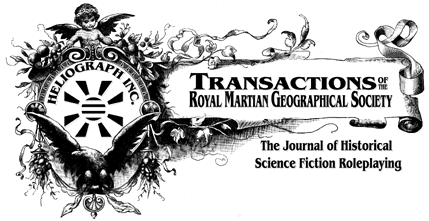
Buy | Submit | TRMGS1 | TRMGS2 | TRMGS3 | TRMGS4 |TRMGS Main | Heliograph Main
|
WHAT'S NEW?
The Complete Canal Priests Of Mars is now available!
The original publication of Canal Priests Of Mars cut slightly over a third of author Marcus L. Rowland's manuscript to fit GDW's adventure format.
The Complete Canal Priests Of Mars restores the cut material, features all new artwork by Paul Daly, and adds many useful player handouts. Enjoy the "author's cut" of a classic Space 1889 adventure, or experience it for the first time!
See our Buy It! page for more information!
Old news is still available on the News Page.
|
The Martian Canal Shark
by Vince Cleaver

From the papers of the late Dr. Jonathan Hollingsworth
There are many terrors native to Mars: the
ravenous Roogie, the mysterious Magoo, the sly Knoe Shoshu.
However, there is one beast that kills far more travellers than
any other the craven Canal Shark. I am well
acquainted with this almost mundane terror, ubiquitous as it is in the Martian
canals. Although primarily a scavenger, it is a skilled opportunistic killer. Yet few
Martians have ever been bothered by it; instead, it dines on the foolish and the unlucky, many of them men of Earth.
When I came to Mars, seeking challenge and adventure, I was
not disappointed. Indeed, my fascination with the canal shark stems
from an incident on the first expedition I was invited on. Part of the
journey was via canal, and one day, not long after our noon meal, a
Martian cabin boy fell overboard. He had been teasing the sharks with a
bucket of slops, and slipped. My companions sprang to save the boy,
dispatching a number of the beasts and rescuing him. He was badly mauled
and nearly died. Between my poor skill and his rugged native
constitution, he pulled through, though he lost his right foot. He is today my valet
and assistant.
Naturally, this affair aroused my curiosity about the creatures, and
I obtained a carcass to examine. My dissection revealed that the
canal shark is not a fish, as one might assume by the name, but a sort of
a finned reptile, much like the fish lizards of Venus. The one which I
examined was a gravid female with a dozen eggs in her womb. When I
opened the eggs to check their contents, I was astonished to find
well-developed young. In this way, I am given to understand, they are rather like
earthly sharks.
The odd contents of the stomach could have originated in a
regular shark as well. I discovered a bit of broken native crockery,
somehow tasty to the shark, and a great quantity of small pebbles. Apparently,
the canal shark used them for ballast. I am grateful to Captain
Meavus McCleod for suggesting this explanation to me. He reminded me
that the crocodiles of Egypt use pebbles for ballast and to help them
digest their food. Since the pebbles in the canal shark are smooth, they
may also perform both functions as well.
The unusual thing about Martians is that, by and large, they have
no fear of the sharks, despite the number of Europeans who have
been eaten by these creatures. After some effort, I discovered that
Martians make use of a native plant, the Oontha vine. Only mildly disgusting
to the human nose, it repels canal sharks without fail. Oontha grows at
the waterline of the canals, normally as a cluster of vines with very
tough roots. When the canals are at high flow, the plant flowers and
reproduces. At other times of the year, fragments of the plant can be
found everywhere, washed up against levees, sewer-gratings and wharfs,
clinging tenaciously. A species of small swimming rodent builds its nests
out of the vines in urban areas.
My young assistant (Marzipan, as my sister Penelope named him
for his favorite snack), had no Oontha paste to protect him that day as
he went about his usual chores as a cabin boy. Poor lad, sent to do a
dangerous if entertaining job. Such is the life of many poor Martian
children. There is little one can do about it, but I have helped poor Marzipan,
who now has a wooden foot and helps me as sort of a medical apprentice.
He is a daily reminder to me of our mission to help and civilize his race,
and do away with the terrors we can banish, unlike the canal shark:
fear, hunger, and disease.
Posted Monday, 04-May-2009 19:50:06 EDT
Return to Main Page
Comments to webmaster@heliograph.com
The material on this page is Copyright 2000 under the author or artist's name unless noted otherwise, and cannot be used without permission. This presentation Copyright 2000 by Heliograph, Inc. Space:1889 is a registered trademark of Frank Chadwick, all rights reserved, and is used with his permission. Most other game, movie, or book names may be trademarks of their respective holders, and use of a trademark at this site should not be construed as implying the sponsorship of the trademark holder, nor, conversely, should use of the name of any product without mention of trademark status be construed as a challenge to such status. Heck no! We love those guys.

